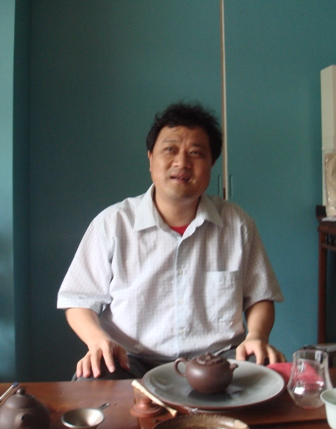Taiwan artist turns calligraphy into social art
 Calligrapher Chen Hsih-hsien injects an innovative grassroots element into Chinese calligraphy
Calligrapher Chen Hsih-hsien injects an innovative grassroots element into Chinese calligraphy
As digital tools replace handwriting in the computer age, many people still find calligraphy, from grinding ink to actually writing, a good means of self-cultivation. Yet Taiwanese artist Chen Hsih-hsien approaches the art as performance, storytelling, and a form of exchange between people and times.
"The traditional functions of calligraphy have largely been lost or replaced, and what makes a calligraphic work interesting today is the modern expression of an individual’s feeling, a practice of contemporary, localized aesthetics," Chen said in an interview.
Chen, author of four books and several community cultural projects featuring his calligraphy, knew from the beginning of his career he did not want to spend his time alone in a studio imitating classical writing styles that evolved in ancient China.
"As the child of a poor family from southern Taiwan, I am not able to write like a Chinese court calligrapher of long ago, nor can my writing catch the charm in the style of Emperor Huizong of the Song dynasty [960-1279], however hard I work at imitating it," Chen said.
"Imitating ancient masters is only the first step toward becoming skilled in character writing, but that is just a technical part to the art," he said.
Chen draws his inspiration from daily life and reflection, rather than from texts written by the ancient Chinese literati. For him, calligraphy is a way for an artist to interact with his environment and society.
Chen fashioned Chinese characters into imagery from things all around him, with resulting works of a single character or groups of characters amounting to simultaneous abstract paintings and concretized ideas.
He believes this kind of Chinese calligraphy can communicate with people, in particular those who do not read Chinese. In his pieces, he uses expressive lines, colors and spatial arrangement to tell stories.
"His calligraphy has become something of a multidimensional thing, where emotions, plots, and even social background are condensed into a character," commented Chen Jing-jieh, publisher of the artist’s latest calligraphic story, "Sunrise, Sunset."
These works are the result of hours of labor and patient waiting. After almost 20 years of focusing on one thing, Chen Hsih-hsien said, he can now confidently find the right characterization for an idea.
In recent years, Chen joined local handicraft businesses to develop calligraphy-based cultural products. An ongoing project making book bags printed with his calligraphic renderings of local identities from around Taiwan.
This series will be displayed at the XVIIIth JAALA International Art Exhibition at the Tokyo Metropolitan Art Museum Aug. 11 to 19. With this show, Chen said, he plans to articulate the rising Taiwanese subjectivity for a foreign audience.
His willingness to make friends and share ideas is the secret to his success, Chen believes.
Source: Taiwan Today



